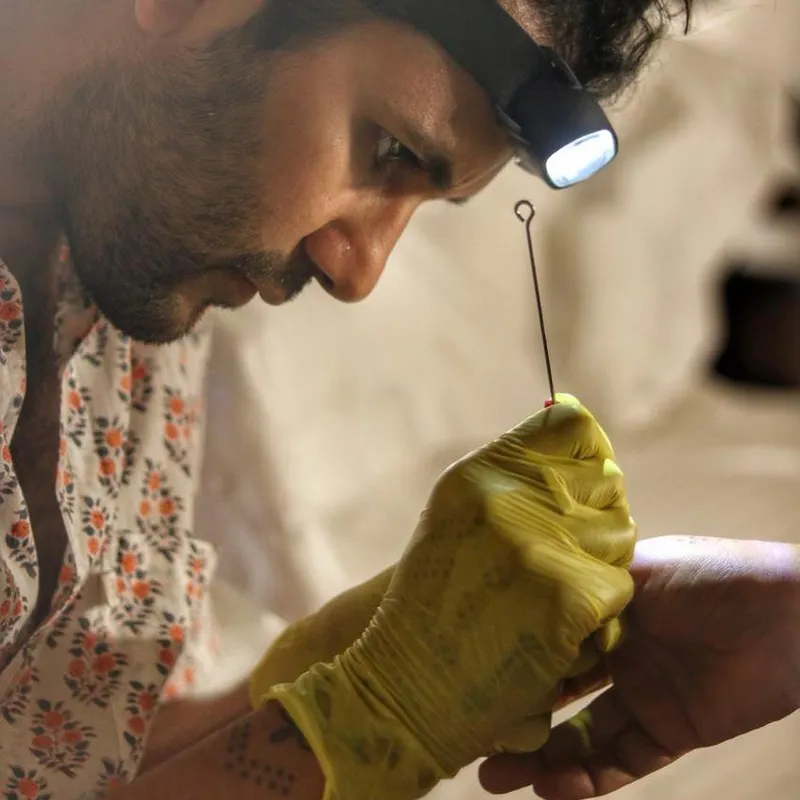A tattoo artist is archiving traditional tattoo designs to help people reconnect with cultural roots
Started in 2021, India Ink Archive is an Instagram archive of indigenous tattoos from across India.
An asterisk on wrinkled hands, dotted patterns on the forearms, scorpions crawling around the neck, and a lotus blooming on the forehead—India Ink Archive—is filled with images of indigenous tattoos from across the country.
A brainchild of tattoo artist Shomil Shah, the Instagram page, which began its journey in 2021, has more than 8,000 followers.
In 2018, Shah, a graphic-designer-turned-tattoo-artist from Mumbai decided to get a Kolam design tattooed on his hand while he was living in London. Intrigued by the process, he started exploring tattoos further. Within a month, he purchased a DIY stick-and-poke kit, diving into the art of tattooing.
Gradually, Shah immersed himself in the rich history of the art. Slowly Shah’s interest in tattooing peaked which eventually led him to start the India Ink Archive.
“The main idea of this project is to create a database of different tattoo designs along with providing a way for people to connect with their ancestors,” Shah tells SocialStory.
The inspiration

Shomil Shah
When Shah got his first tattoo, his mother told him that he was not the first in his family to be intrigued by the art of tattooing. His great-grandmother also had vivid and beautiful designs inked on her neck and arm.
“I never met my great-grandmother so I had no idea that she had these tattoos. But my mom vividly remembered them. She belonged to Kutch, Gujarat and a couple of generations back, it was kind of customary for people to have tattoos, especially women,” he adds.
Shah recalls that he could hardly find any information on indigenous tattoo designs. The lack of documentation and his interest in tattooing inspired him to create a comprehensive archive of tattoos from across India that have long faded.
In 2019, he decided to take a sabbatical and travelled to different parts of India including, Gujarat, Maharashtra, Karnataka, Madhya Pradesh to know more about old tattoo designs.
During his travel, Shah would approach elderly women he encountered and engage them in conversations about the significance of their tattoos. With their permission, he would capture photographs of these inked artworks, documenting the stories behind them.
"Initially, many older women were hesitant to open up to me, being a young boy. But I found that showing them my own tattoo served as an icebreaker, bridging the gap between us,” Shah says, “It's remarkable how tattoos have a language of their own, connecting me with numerous individuals and providing a comfortable space for conversation."
Blurring the boundaries
Babli Bai, a 70 years old woman from Bandra, Mumbai was the first woman to be featured on the Ink Archive page. She was first tattooed when she was around age 10. She had banana plants, a snake and a lotus motif inked on her left arm and Krishna’s milkmaids, motif of her and her husband as well as her husband’s name on her right arm.
Bai also had markings of a scorpion, a crescent moon at the back of her hand and a few dots on her face.
Shah observes that the art of tattooing gradually faded over time, as the previous generation was preoccupied with the demands of raising families and fulfilling responsibilities, leaving little room for preserving this ancestral art form.
However, he firmly believes that the current generation yearns to reestablish a connection with their roots, seeking a deeper understanding of their culture and embracing the resurgence of tattooing as a means of cultural expression.

“India has a rich history of tattooing which has not been well documented. Tattooing is a beautiful art form and its meaning is fluid. For our ancestors, it was a symbol of their identity, a mark of their community or status and for our generation, they are more of a creative way of self-expression,” he adds.
While documenting, Shah realised that many designs remained the same across borders with little to no modifications. He explains that the scorpion motif is one of the most common design he has seen in MP, Gujarat, and Karnataka.
“It is so surreal how certain motifs are present so far apart but are still the same,” he says, adding, “I feel this somewhere shows us that these state boundaries are a relatively modern concept.”
He further explains that the similarities in motifs could also be credited to the fact that the nomadic tattoo artists moved across India, taking their art along with them.
The Gonds, a tribe found in MP, Chhattisgarh, Maharashtra, Andhra Pradesh, Gujarat, Jharkhand, Karnataka, Telangana, Uttar Pradesh, West Bengal and Odisha, are an example of this migration. Their migration to different parts of India has influenced the spread and diversification of tattooing practices and designs.
Shah says he has observed that women from Maharashtra and Madhya Pradesh frequently exhibit similar floral symbolism in their tattoos, which are often referred to by distinct names.
“The Trajva style, commonly associated with northern Indian states such as Rajasthan and Gujarat is also found in Pakistan's Sindh province. This shows how tattoos blur the man-made boundary and connect us with the neighbouring nation,” he adds.
The homecoming

Stick and poke method of tattooing
Shah wants to collect and document whatever remains of this ancient art. However, he does not want to be known as a preserver of the indigenous tattoos. “I started this with my own interest and I have not delved extremely deep into the subject. So I am not an expert on the topic,” he says.
Shah says that the archive means to celebrate the old traditions and bridge the gap between generations through tattoos.
He remembers numerous instances when people discovered their ancestral tattoos through his page. One particular story stands out, as a man reached out to him, sharing that his late grandfather had a scorpion tattoo. Eager to learn more about its significance, he turned to Shah's page, finding a deeper understanding and connection to his family's tattoo heritage.
“These heartwarming encounters do make me happy,” he says.
In another instance, a woman messaged Shah to help her find the meanings of the tattoos her grandmother had so she could get them inked on her hand.
In yet another incident, Vena, a woman of Tamil origin inked her grandmother’s Godna markings. The markings were intricately crafted in their village of Pasea in Trinidad. Inspired by Ajee's tattoos, Vena and her cousins have chosen to replicate some of the designs on their own skin.
The difference between stick and poke and machine tattoo is the speed at which the needle penetrates the skin. Shah says that the same designs can be made quickly with a machine but he prefers the slower method.
“I like the slowness of the stick-and-poke process. Additionally, I work with non-complex designs so I prefer that technique,” he says.
Shah believes that there is a vast array of tattoos, yet insufficient documentation. To address this gap, he started featuring crowdsourced images on his page, recognising the collaborative effort required. “It would have taken me a few lifetimes if I did it all alone,” he adds.
Now, Shah looks forward to further growing the page and delving deeper into the topic.
"This archive aims to serve as a tool in rekindling traditional tattoo designs and provide people with the opportunity to engage and reclaim their roots through this ancient art form,” he says.
Edited by Affirunisa Kankudti







